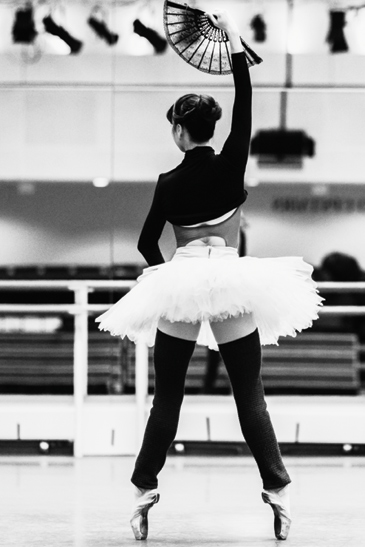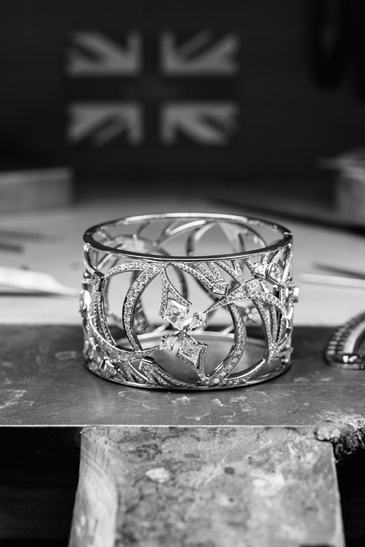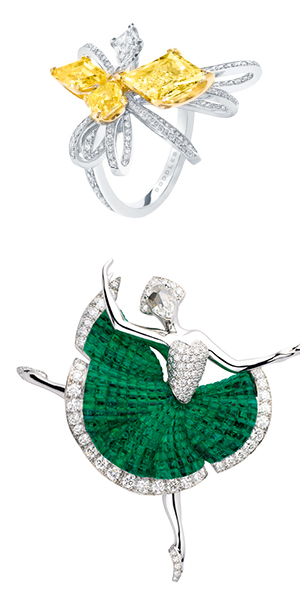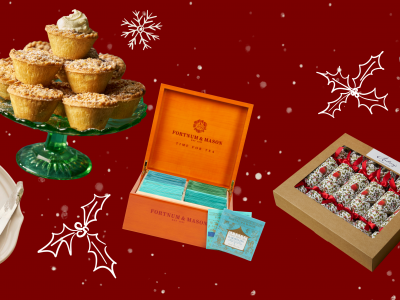Two years in the making, Boodles Pas de Deux high jewellery collection offers an extraordinarily beautiful and thrillingly abstract evocation of the Royal Ballet and its work, as seen through the eyes of the brand’s designer, and lifelong ballet fan, Rebecca Hawkins. Talking to her, it is easy to see how dance captures the imagination of creatives in other fields and how there is far more to it than simply interpreting its unique spirit of movement, skill and beauty.
Boodles collection inspired by Royal Ballet
13th March 2015
An exquisite new offering from Boodles prompts Avril Groom to explore the carefully choreographed relationship between jewellery, ballet and fashion
The idea came from an internal Boodles discussion about linking in with some aspect of the arts — as so many luxury companies now do — in addition to its existing sports sponsorship. Hawkins, who had always been a regular at Royal Ballet performances, immediately suggested the company and was warmly received when she contacted the Royal Opera House. “When they discovered I intended to base a collection on the Royal Ballet, they made me very welcome and I was given access to so many aspects, from rehearsals to the costume and make-up areas,” she says.
Hawkins found the wealth of inspiration almost overwhelming: “It was easy to get distracted from my original idea about the purity of ballet movement.” So she worked closely with the Royal Ballet’s associate director, Jeanetta Laurence, to discover what it is that makes ballet, and this particular company, unique. “We found there were huge parallels in the way we work and in our principles,” Hawkins says. “The idea of complete perfection, of working with and being the best, of the minute attention to detail — it’s all as essential to the ballet as it is to our jewellery making.” So the idea of Pas de Deux was born, not only the name of the classic ballet duet, but also a statement of the harmony and closeness in attitude between the two companies.
From this point, Hawkins began to study the movement of the dancers, the patterns and shapes made by their bodies, even the plans of the steps marked out by their feet. She found herself sketching out sequences of strong, straight lines representing the dancers’ bodies and limbs, and fluid curves reflecting their graceful movements.
The shapes suggested to her several unusual cuts of diamond — kite shapes to represent arrow-straight limbs, softened, rectangular Ashoka cuts and marquises, all at angles to show movement and balance. The result is a collection of surprising modernity, grace and contrast, not immediately redolent of ballet yet, when the connections are revealed, completely apposite. Each piece has its own inspiration and most are unique, not least because of the rare and sizeable stones involved.
“So often we are inspired by the stones first,” says Hawkins. “However, in this case I knew exactly which cuts I wanted, to give different senses of movement. We were lucky to find three amazing kite-shaped yellow diamonds [which have been worked into a grand ring, the stones exploding firework-like at different angles] but we had to have the white diamonds cut to order.” Kite shapes are rarely cut, partly because of the wastage they entail, and lining up these stones alone took six months. The Ashokas, often ‘balanced’ at angles on one corner in pairs, representing the dancers of the pas de deux, and the marquises, were only slightly easier to find because of the large sizes and flawless quality that Hawkins felt appropriate. Making the items was equally painstaking and time-consuming, creating the complex mix of geometric angles and fluid curves, and of finely cut precious metal that gives delicacy and strength — both also dominant features of ballet.
The collection’s late-June launch will be followed by a tour of Boodles’ stores, so that existing and new clients can see the 30-plus pieces. In September comes the other part of this reciprocal arrangement: Royal Ballet performances of Romeo and Juliet sponsored by Boodles. Customers will
also receive a beautiful book of pictures by photographer Charlie Dailey, who shadowed Hawkins’ visits to the Royal Opera House and captures the intimate moments that inspired her — dancers rehearsing and relaxing, trying on costumes, doing their make-up and even, on special occasions, wearing the jewels.
Boodles' new range is unique in it's abstract, modern mix of angularity and fluidity
It is a wonderful record of what Hawkins finds so enthralling about the ballet and an eloquent statement of dance’s wider and enduring fascination for the worlds of fashion and jewellery. As early as 1928, Coco Chanel was asked by Diaghilev to design costumes for the Ballets Russes. Chanel’s current designer, Karl Lagerfeld, has followed in her footsteps for various ballet companies as, in the 1980s, did Christian Lacroix, Jean Paul Gaultier and Jasper Conran, while Halston’s draped jersey was a perfect fit with Martha Graham’s contemporary dance company.
With American design duo Rodarte designing costumes for the Oscar-winning ballet film Black Swan and last year’s Dance and Fashion exhibition at New York’s Fashion Institute of Technology, the practice is back in the spotlight, with contemporary designers such as Riccardo Tisci of Givenchy, Stella McCartney and Joseph Altuzarra contributing ballet costumes. The New York City Ballet is keen to use fashion designers while its own costume designer, Marc Happel, admits to being influenced by Christian Dior and Cristóbal Balenciaga.
The reverse process is equally significant. Exotic costumes by the Ballets Russes’ designer Léon Bakst influenced Paris couturier Paul Poiret to work with bright colours and freer, uncorseted shapes before 1920, but the game-changer was Yves Saint Laurent. His 1976 Ballets Russes collection of jewel-coloured, full peasant skirts and blouses, cinched-in waists and gorgeously embroidered waistcoats not only influenced general fashion at every level, but made the ballet a perennial source of inspiration for designers.
Oriole Cullen, who curated the 2010 exhibition on the Ballets Russes at the V&A, sees its influence in the work of current designers from Erdem to John Galliano, who once had model and trained dancer Shalom Harlow pirouetting through the audience in a tutu-cum-ballgown.
In recent seasons, the links have grown closer. The nude pink so associated with ballet shoes and ballet practice kit has become a new neutral to compare with black, white and grey. It is often mixed with black, especially for lace and embroidered evening dresses, in a combination also favoured for ballet costumes. Italian cashmere designer Brunello Cucinelli works mainly with muted neutral shades and has made the typical ballet warm-up combination of a soft knit with a very light, floaty tulle or chiffon skirt into a new classic, often photographed in a balletic way. The ballerina pump, meanwhile, has become the go-to flat shoe for working women wanting a break from stilettos. The latest collection from Jimmy Choo goes further. Creative director Sandra Choi was inspired by the delicacy and discipline of dance to create Bondage Ballerina, with ballet-inspired shapes, nude leather and velvet, but also high heels and the crossover ties and bows of ballet shoes and costume corset ribbons.
Tying into a performance, as Boodles is doing, is also a growing trend. Luxury brand Tod’s started it several years ago by funding backstage restoration at La Scala in Milan and making a promotional film that included a specially commissioned, abstract ballet. Dolce & Gabbana love to show their made-to-order alta moda range — the Italian equivalent of haute couture — at a grand occasion for wealthy clients; their ballet-inspired Spring 2015 collection was shown in the foyer of La Scala and included a performance from leading dancer Roberto Bolle in a spectacular hand-beaded tunic. Even the accompanying fine jewellery features tiny gold and diamond ballerinas in silk tulle tutus.
Although Boodles’ new range is unique in its abstract, modern mix of angularity and fluidity, it is far from the first jewellery to be inspired by ballet. Van Cleef & Arpels’ dancer brooches date back to 1940 and come in a myriad of different stones and designs. They are stunning examples of the jeweller’s craft, often featuring the house’s signature mystery setting, where no metalwork is visible between the stones, and a pear-shaped diamond as the dancer’s face.
It was easy to get distracted from my original idea about the purity of ballet movement
In 1967, Van Cleef & Arpels linked with legendary choreographer George Balanchine to create Jewels, a ballet celebrating emeralds, rubies and diamonds, which has been performed worldwide, including by the Royal Ballet in 2007. The house developed an 80-piece collection around it with new dancer brooches still being added to great acclaim.
In a more contemporary mood, a 2010 collection by Brazilian jeweller H Stern celebrated the exuberant and evocative work of modern dance troupe Grupo Corpo. Designer Roberto Stern immersed himself in the group and produced beautiful pieces, some now classics in the Stern range, that are all about lightness and movement.
No doubt ballet will inspire many other breathtaking pieces and spectacular dresses in the future, but Boodles’ Pas de Deux, in terms of craft and beauty, has set a high bar.










